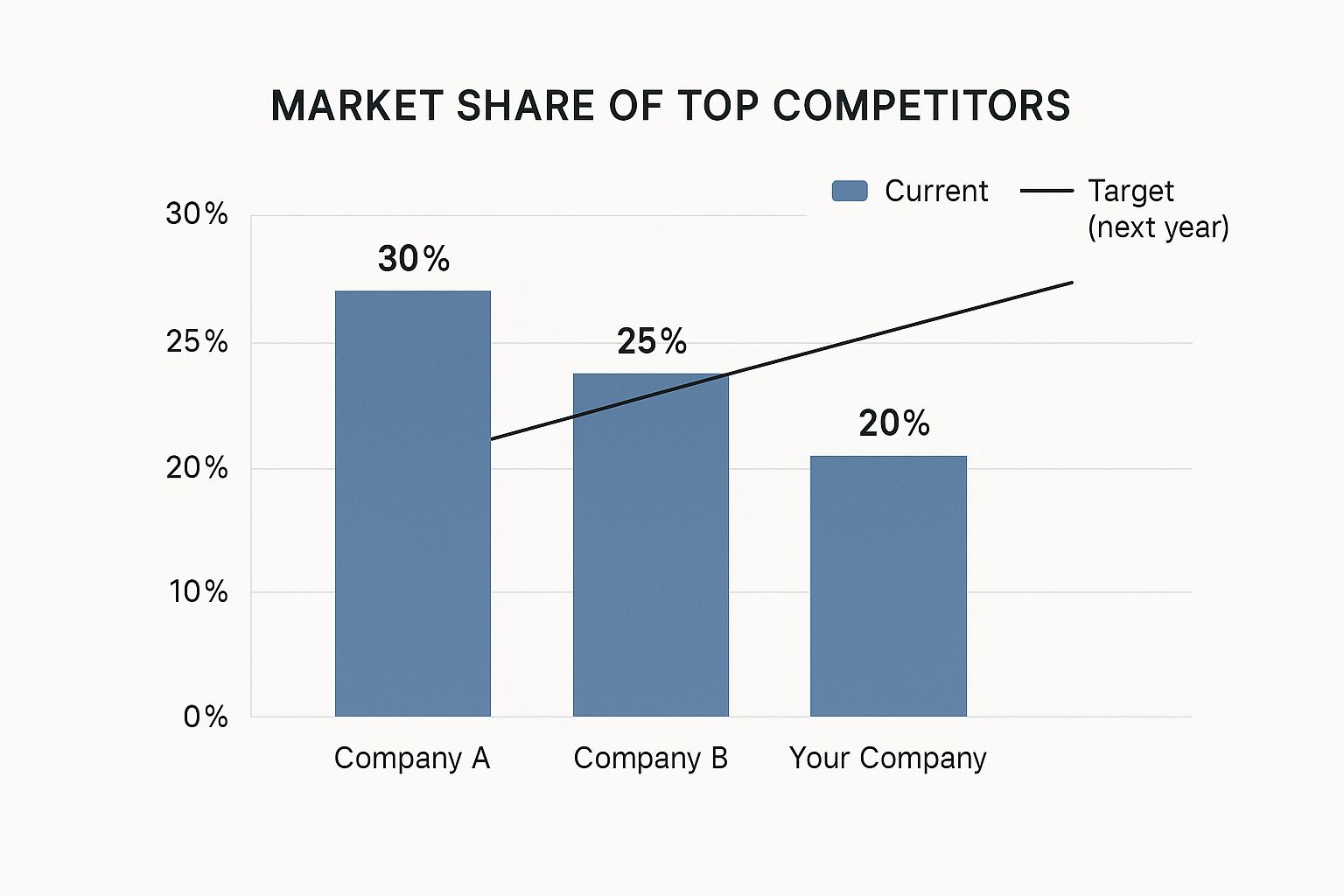Capturing a larger slice of your market doesn't happen by chance. The essential first step is to get a clear, data-driven understanding of your current standing. This means pinpointing your market position, sizing up your competition to find their vulnerabilities, and identifying customer segments that others are overlooking.
This initial analysis provides a strategic roadmap. It’s the difference between blindly hoping for growth and making a calculated move to win more business.
Pinpointing Your Current Market Position
Before charting a course for growth, you need an honest assessment of where your business is right now. Gaining market share is about precision, not vague ambition. That precision starts with knowing your exact coordinates in the competitive landscape.
This goes far beyond a quick glance at your annual revenue. You must dig deeper to see how your sales compare to the total sales for your entire industry.
Calculating your market share gives you a solid benchmark. For instance, if your industry generated $100 million in sales last year and your company brought in $10 million, you hold a 10% market share. This single metric is your starting line—it helps you set realistic growth targets and measure your progress effectively.
Understanding the Competitive Landscape
Once you have your number, it’s time to map out the competition. Who are the key players? What gives them their edge?
A classic SWOT analysis (Strengths, Weaknesses, Opportunities, Threats) is an excellent tool for this. It compels you to be brutally honest about your own company while keeping a sharp eye on external market forces.
Perhaps you discover a top competitor is known for poor customer service. That’s not just a weakness for them; it’s a golden opportunity for you to attract their frustrated customers with a superior experience. Conversely, a threat might be a new, well-funded startup entering the scene, signaling that it’s time to double down on customer loyalty.
A deep analysis of your market position isn't just busywork. Think of it as a strategic intelligence mission. You're looking for chinks in your competitors' armor and untapped pockets of customer demand that are yours for the taking.
To get a clearer picture, it's helpful to organize your analysis. This framework breaks down the essential methods for evaluating your standing.
Market Share Analysis Framework
Analysis MethodKey MetricPrimary GoalMarket Share Calculation(Your Sales / Total Market Sales) x 100Establish a baseline percentage of the market you currently own.SWOT AnalysisStrengths, Weaknesses, Opportunities, ThreatsIdentify internal advantages and external factors to exploit or mitigate.Competitor BenchmarkingShare of Voice, Customer Reviews, PricingSee how you stack up against direct rivals on key performance indicators.Customer SegmentationDemographics, Buying Behavior, Pain PointsUncover underserved or high-potential customer groups to target.
Using this structured approach ensures you're not just gathering data, but turning it into actionable intelligence for your growth strategy.
This visual shows a common scenario where a company is a strong contender but still has a clear path to becoming the leader.

As you can see, closing the gap between your 20% share and Company A's 30% becomes a much more tangible goal when you visualize it this way.
The Power of Dominant Market Share
Becoming a dominant force in your market creates a powerful flywheel effect. The more customers you acquire, the more trust you build, which in turn attracts even more new customers.
Consider Google. As of early 2024, it commands a staggering 91.47% of the global search engine market. This leaves competitors like Bing with just 3.42%. You can explore more of this data by checking out these search engine market share insights.
Google’s dominance wasn't an accident; it was built on a foundation of user trust and a superior product, creating a lead that's now nearly insurmountable. This is the ultimate goal, and it all starts with knowing exactly where you stand today.
Crafting a Winning Competitive Strategy

To gain more market share, you must give customers a compelling reason to choose you over the competition. It isn’t about being slightly better; it's about becoming the only logical choice for your ideal customer. A solid competitive strategy gives your brand a genuine edge that is difficult for others to replicate.
The process begins with a deep understanding of your competitors. Don't just glance at their product pages. Dig into their marketing blind spots, see what people are saying about their customer service, and pinpoint where their promises don't align with reality. Every gap you uncover is an open door for your business to step in and win over a piece of their audience.
Choose Your Competitive Approach
Most winning strategies boil down to one of three core approaches. The right one for you hinges on your company’s strengths and the market landscape. You can't be everything to everyone, so focus your energy where you can make a real impact.
- Cost Leadership: This is about becoming the most efficient, lowest-cost producer in your field. Think of brands like Walmart or IKEA. They win by offering solid quality at a price that competitors find nearly impossible to match, naturally attracting a large, price-conscious customer base.
- Differentiation: With this approach, you focus on creating a product or service that feels truly superior. Apple is the quintessential example, commanding premium prices due to its focus on design, user experience, and a powerful brand ecosystem. People don't buy Apple because it's cheap; they buy it for the distinct value it provides.
- Niche Focus: Here, you concentrate on a specific, often overlooked, segment of the market. Instead of trying to win the entire ocean, you aim to be the biggest fish in a small pond. A local artisanal coffee shop that caters exclusively to coffee connoisseurs is using a niche strategy to thrive against large chains.
Once you’ve selected your general direction, it's time to sharpen it into a message that resonates.
Define Your Unique Selling Proposition
Your Unique Selling Proposition (USP) is the beating heart of your competitive strategy. It’s that one thing that makes you different—and better—in your customer's mind. A great USP clearly answers the question: "Why should I buy from you and not your competitor?"
It needs to be specific, persuasive, and, most importantly, something you can consistently deliver on. Domino's Pizza, for example, built an empire on a brilliant USP: "You get fresh, hot pizza delivered to your door in 30 minutes or less, or it's free." That wasn't just a catchy slogan; it was a concrete promise that solved a major customer pain point—slow, unpredictable delivery.
A well-crafted strategy makes your brand memorable and defensible. It shifts the conversation from price to the unique value only you can offer, which is the cornerstone of any plan for increasing market share.
From this point on, your strategy must influence everything you do—from product pricing to marketing communications. You'll often need to get aggressive with targeted campaigns to get your message out there and reach new audiences. In fact, many businesses find that exploring how PPC marketing can help with market expansion is a critical next step. It lets you put your unique message right in front of people who are actively looking for what you sell, fast-tracking your journey to capturing more of the market.
Driving Growth Through Product Innovation

In a crowded market, a good product is merely the price of entry. The brands that truly pull ahead are those that never stop innovating, creating products and services that become indispensable. When you place product innovation at the heart of your strategy, you stop playing catch-up and start setting the pace for everyone else.
This isn't about chasing trends or the latest tech fads. True innovation comes from a direct line between customer feedback and your development team. It's a disciplined loop where customer insights, market data, and emerging needs feed your R&D pipeline. The goal is a forward-looking roadmap that solves today's problems while anticipating what customers will want tomorrow.
Balancing Flagships with Accessibility
One of the most powerful ways to increase market share is to build a tiered product lineup. This strategy is about capturing different market segments simultaneously, appealing to both high-end buyers and those who are more budget-conscious.
The smartphone market is a masterclass in this approach. Major players skillfully balance their cutting-edge flagship launches with competitively priced mid-tier models. For example, Samsung recently held its top spot by shipping 60.1 million units in Q1 2024, a success driven by both its new premium Galaxy S24 series and its popular A-series. Meanwhile, Apple captured a 17.3% market share by meeting demand across diverse global markets. You can see more on these smartphone market dynamics and how this blend of innovation and accessibility is a proven path to growth.
By offering products at different price points, you open your brand up to a much wider audience without diluting the prestige of your top-tier offerings.
Turning Customer Feedback into a Competitive Edge
Your current customers are a goldmine of R&D intelligence. They use your product daily and understand its strengths and weaknesses better than anyone. If you want to know where to innovate next, start by actively listening to them.
To do this effectively, you need to build clear, consistent channels for gathering their input.
- Go Beyond Basic Surveys: Don't just ask about satisfaction. Dig deeper with targeted questions about which features get the most use, what they wish the product could do, and what frustrations they encounter.
- Analyze User Behavior: Use analytics to track how people actually navigate your product or site. This behavioral data often reveals pain points and opportunities that customers can't always articulate.
- Have Real Conversations: Make it a habit to schedule interviews with a mix of users. These conversations provide the "why" behind the data, adding crucial context to your analytics.
Your most valuable product roadmap isn't brainstormed in a boardroom; it's co-created with your customers. Every piece of feedback is a breadcrumb that can lead to your next market-capturing innovation.
When you weave this customer-centric mindset into your development process, you ensure that every new feature and product update is grounded in a real-world need. This not only boosts loyalty but also builds a powerful reputation as a brand that listens and responds, making you a much tougher competitor to dislodge.
Expanding Your Reach to New Markets
To make a significant impact on your market share, you can't just keep fighting over the same territory. Sometimes the smartest move is to find a completely new audience. Pushing into new markets—whether that’s a new city, country, or customer demographic—is a classic, powerful growth strategy.
This isn’t about making blind guesses. It's a calculated process of identifying and validating opportunities with minimal risk. The goal is to pinpoint geographic or demographic areas where your offering can solve a problem that is being ignored or poorly addressed by current players.
Finding and Testing New Opportunities
Before you invest heavily in a new market, you need to be sure there’s a genuine opportunity. Your first clue is often hiding in your own data. Analyze your existing customers. Are you seeing a surprising number of orders from a city or industry you don't actively target? That's not a coincidence; it's a signal.
Once you have a hunch, it's time to dig deeper with focused research.
- Check Search Traffic: Use keyword research tools to see how many people are searching for what you sell in the target area. High search volume and weak competition is a strong positive indicator.
- Scope Out Local Competitors: Who are the dominant players in that market? Analyze their pricing, messaging, and customer reviews. You're looking for gaps—the things they aren't doing well that you can excel at.
- Run a Small Test: Don't go all-in at once. Start with a low-risk pilot program. This could be a highly targeted digital ad campaign or a partnership with a local distributor to test initial traction.
Consider a hotel in Los Cabos. By analyzing booking data, they might spot a sudden spike in guests from Texas. That's the perfect trigger to launch a focused ad campaign in Dallas and Houston. This same logic applies to any business, and you can see how this data becomes a full-blown strategy by exploring specific tactics for marketing a hotel in a new region like Baja.
Entering a new market shouldn't feel like a gamble. Treat it like a calculated experiment. Start small, gather real data, prove your concept, and only then do you accelerate your investment.
Building a Real Local Presence
Simply shipping your product to a new region often isn't enough. To truly succeed, you need to build a genuine local presence. This is where strategic moves like foreign direct investment (FDI) can be a game-changer.
Setting up local operations—a factory, warehouse, or even a small sales office—sends a powerful message of commitment to the market, which builds trust with local customers. It also drastically reduces shipping times and logistical complexities.
We're seeing this happen on a massive scale across North America. The trend of "nearshoring" has driven a significant increase in foreign investment. For example, in 2023, Mexico attracted over $36 billion in FDI, with a substantial portion flowing into manufacturing as companies moved production closer to North American consumers.
By tapping into these economic currents, you can position your own business for a similar leap. Pushing into new territories is one of the most effective ways to grow your market share, turning untapped potential into real, sustainable revenue.
Mastering Customer Acquisition and Retention

If you're serious about capturing a larger market share, you need a two-pronged attack. It's about being a magnet for new customers while simultaneously being the superglue for the ones you already have. Pouring all your resources into acquisition without a solid retention plan is like filling a leaky bucket—a costly and frustrating exercise.
Sustainable growth happens at the intersection of these two efforts. You need a steady stream of new business coming in and a rock-solid strategy to turn those first-time buyers into loyal, repeat customers. This balance is the key to expanding your footprint and building a powerful, revenue-generating base.
Strategies to Attract New Customers
Wrestling customers away from established competitors isn’t about shouting the loudest; it’s about precise, targeted action. You need to show up where your ideal audience is already looking for solutions and give them an irresistible reason to choose you.
A strong digital presence is non-negotiable. By mastering your online strategy, you can capture attention at the exact moment a potential customer has a problem you can solve. If you're building from the ground up, understanding why SEO is important for business growth is a great starting point—it’s the foundation of modern customer acquisition.
Here are a couple of powerful tactics to pull in new business:
- Forge Strategic Partnerships: Find non-competing businesses that serve the same audience. A B2B software company partnering with a respected accounting firm to co-host a webinar is a classic win-win, instantly providing credibility and access to a fresh pool of qualified leads.
- Run Hyper-Targeted Marketing: Use data to get specific. Instead of a generic ad campaign, craft messaging that speaks directly to the pain points of your competitor's customers. Position your product as the obvious, superior solution to their exact frustrations.
Building Fierce Customer Loyalty
Consider this: acquiring a new customer can cost five times more than retaining an existing one. That statistic alone illustrates that retention isn't just a "nice-to-have" activity; it's an economic imperative for growing your market share.
Loyal customers do more than make repeat purchases. They become your most effective marketing channel through word-of-mouth referrals. The goal is to evolve beyond simple transactions and cultivate genuine brand affinity.
A retained customer is your most valuable asset. Their loyalty not only provides stable revenue but also becomes a powerful force for organic growth, turning your existing base into a volunteer marketing army.
To build this kind of loyalty, you must consistently deliver exceptional value long after the initial sale. It’s about the entire customer experience, from onboarding to ongoing support.
Understanding where to focus your efforts is key. While both acquisition and retention are crucial, the tactics you use for each are quite different.
Customer Acquisition vs. Retention Tactics
This table breaks down how similar strategies can be adapted for either attracting new faces or delighting your current customers.
Strategy FocusAcquisition Tactic ExampleRetention Tactic ExampleCommunity & EngagementHost an industry-wide webinar to attract new leads.Create an exclusive online forum for existing customers to share tips.IncentivesOffer a significant discount for first-time buyers.Implement a tiered loyalty program that rewards repeat purchases with escalating perks.Service & SupportProvide a live chat demo for prospective clients.Offer proactive, personalized customer support and regular check-ins to ensure success.
Ultimately, by getting both sides of this equation right, you create a powerful growth cycle. New customers flow in, your exceptional service turns them into loyal advocates, and those advocates help you attract even more new customers. That’s the engine that drives lasting market leadership.
Frequently Asked Questions
Trying to grow your slice of the market always brings up some tough questions. Let's tackle a few of the most common ones I hear from business owners so you can move forward with a clear, confident plan.
What Are the Biggest Risks of an Aggressive Growth Strategy?
The single biggest danger is overextension. It's tempting to pour significant resources into a new market or a massive marketing blitz, only to discover the opportunity wasn't as viable as you thought. This can drain cash reserves and divert focus from the core business that pays the bills.
Another major pitfall is accidentally triggering a price war. A larger, deep-pocketed competitor might see your aggressive moves as a threat and slash their prices. They can often afford to operate at a loss temporarily to squeeze you out of the market.
To mitigate these issues, always start small. Run a pilot program in a limited geographic area or with a small audience segment. Gather real-world data and validate your approach before committing to a large-scale rollout.
The goal is calculated expansion, not reckless growth. A smart strategy for how to increase market share prioritizes sustainable gains over short-term, high-risk gambles.
How Can We Measure Success Beyond Just Sales Figures?
While revenue growth is essential, it isn't the whole story. True market dominance manifests in other metrics that indicate long-term stability and customer loyalty.
You need to track these alongside your sales numbers:
- Share of Voice: How often is your brand mentioned online (social media, blogs, news sites) compared to your competitors? A rising share of voice is a strong indicator of growing brand awareness.
- Customer Lifetime Value (CLV): Are your customers staying with you longer and spending more over time? An increasing CLV is a gold-standard measure of true loyalty and business health.
- Net Promoter Score (NPS): This metric measures customer satisfaction and loyalty by asking how likely they are to recommend your brand. A high NPS means you're creating genuine fans who will act as brand advocates.
What Role Does Digital Marketing Play in This Process?
Today, digital marketing isn't just a part of the growth plan—it's often the main engine. It gives you the power to target specific, underserved customer segments that your competitors may have overlooked.
With data-driven campaigns on platforms like Google or Facebook, you can speak directly to potential buyers about their unique problems, making your brand feel like the perfect solution.
For instance, strategic content marketing and SEO help you attract people who are actively searching for what you offer. Paid advertising can place your message directly in front of your competitor's known audience. A robust digital strategy is non-negotiable for any business serious about how to increase market share.
Ready to stop guessing and start growing? Twelverays provides data-driven digital marketing solutions that deliver measurable results and help you capture more of your market. Learn how our tailored strategies can drive your business forward.





